- Bernard Preston homepage
- Legumes
What are legumes?
What are legumes? We live in a world that is increasingly desperate for cheap protein. It's a question we should all be asking. With the Earth's population set to rise dramatically to ten billion people this is a subject we will be forced in the future to contemplate; whether we like it not.
Legumes cost a fraction of the price of red meat providing us with protein from chickpeas, green beans and lentils for example. Moreover they use far less water and unlike cattle and pigs, actually reduce global-warming gases rather than contributing further to climate change.
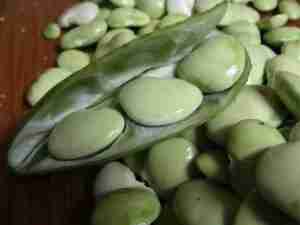 Green lima beans are our favourite.
Green lima beans are our favourite.This page was last updated by Bernard Preston on 9th June, 2024.
This
raises ethical issues of possible short-term gain for the obese. They may be thinking of avoiding legumes for protein because of their starch; and rather eat more meat but at the expense of the planet. This is central to the Cyan Zone philosophy; green issues about Mother Earth and blue ones concerning wellness.
And in any event it is the refined starches in my book that are illegal, immoral and fattening; and not legumes.
The
starch in legumes has the advantage of being resistant to rapid
absorption in the small intestine as compared to that in cereals, roots
and tubers[2]. They have a very low GI.
Added to that the WHO has declared that red-meat is probably a major cause of malignancies; certainly the way animals are raised today. If they were reared in the wild, free to roam as intended in pastures that "most likely" would be "possibly" and perhaps not at all.
These are unpleasant facts for many of us; and some will no doubt continue to be ostriches but the laws of nature are merciless and unforgiving.
Shelling large green beans like limas can be time-consuming but we have found a way to do it quickly and efficiently.
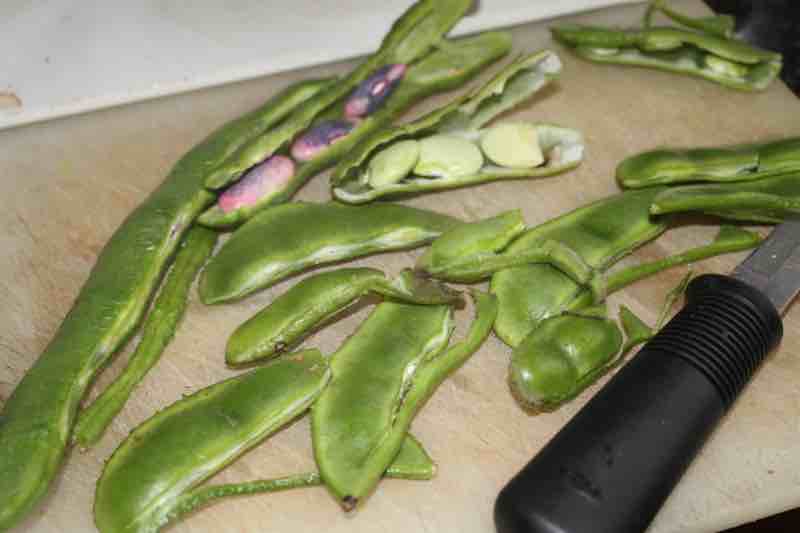
Whether we like it not in the very near future we will be compelled to get initially some and then within a few short years most of our protein from beans and peas. In fact once you learn to cook with them, they are delicious; you will not need statins for example to lower cholesterol and won't be continually and painfully desperately trying to lose weight.
You will be able to enjoy your food without guilt. Eating once again becomes a pleasure.
That is because legumes contain the protein and fibre that give us
the feeling of being sated; virtually all diets leave us constantly
famished, craving the next snack. But not if you enjoy your beans and peas with a little extra fat from say avocados or olive oil.
These fats contain bioactive compounds such as coenzyme Q10 which are very important in the body.
Butter too is
back and should never have been banished to Coventry. Coconut-cream remains controversial but we enjoy it in moderation with many of our dishes because of the satiety it provides.
So understanding legumes is the easiest solution to regain
that modest-waistline. They deal with the hunger that unresolved drives us
remorselessly to snacking, obesity and loss of vitality; and frequent visits to the pharmacist for pain medication.
What are legumes?
What are legumes is also important to grasp for those on very low starch food such as the ketogenic, Banting or Paleo meal-plans. Is that carbohydrate so detrimental that we should avoid it entirely? Beans, peas and lentils are strongly recommended for diabetics.
And what does that mean for a planet faced with serious greenhouse-gas issues?
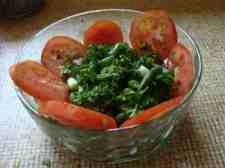
Enjoying green beans and tomatoes is so important in the fight against serious breast and prostate disease.
Cooking green beans of course is a cinch.
How do you thicken curried green beans? It need not be a challenge for those who eschew cornstarch because of its glycemic nature.
Legumes can be divided into those which are a fruit like green beans and peas; and those grown for their dry seeds like lentils. There is much overlap and the distinction is not important except for the botanist.
1. Fruits: green beans and peas
2. Dry seeds
- Pulses: dried seeds of legumes likes beans, peas and lentils.
- Oil seeds: soybeans and peanuts.
What characterises legumes is that they are rich sources of vegetable protein; broad beans, also known as favas have a large amount at 25 percent. One cup will provide you with about a quarter of your daily need for amino-acids.
Mature soybean seeds contain up to 40pc protein; three times that in unrefined wheat and rice. Once the millers get hold of grains most of the goodies are destined for hog food and we are left with the endosperm that makes us fat; cake and bread flour, for example.
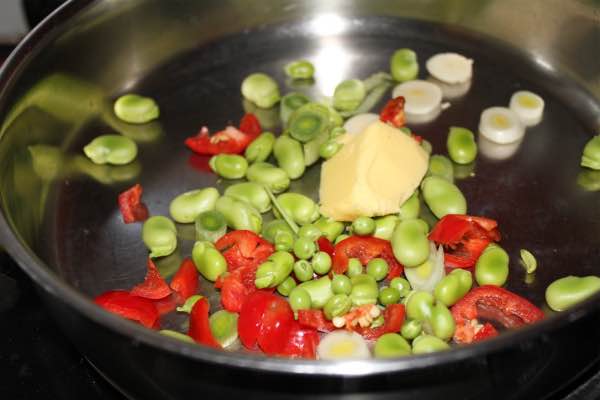 Eggs Hilton gently fries green peas and beans before adding the spinach.
Eggs Hilton gently fries green peas and beans before adding the spinach.Legumes also have a large amount of starch which, unlike that from potatoes and wheat for example has more fibre; much is digested not in the small intestine where it would have produced a surge in blood glucose but in the colon where it is fermented by the normal flora forming excellent short-chain fatty acids.
The starch in legumes is an insoluble carbohydrate consisting especially of amylose which is absorbed more slowly; that is why they have a low glycemic index and are particularly beneficial to diabetics.
The question of the glycemic response to legumes is central to all those whose doctors call for avoidance of peas and beans that might raise blood glucose.
Herein lies the controversy for those prescribed very low carbohydrate food. Have you been fed the fake-news that the starch in legumes will make you fat? And should you be avoiding them at all costs? It is unnecessarily untrue and irksome.
Nevertheless if you are diabetic I recommend you enjoy a meal of legumes with no other starch, and test your blood glucose before and at half-hour intervals after dinner. Four pricks of your finger and you will know quite plainly whether you should be avoiding peas, beans and lentils.
It is most likely not a problem as there is oodles of research showing that diabetics have more stable blood sugar; lower cholesterol and triglycerides with all that fibre too.
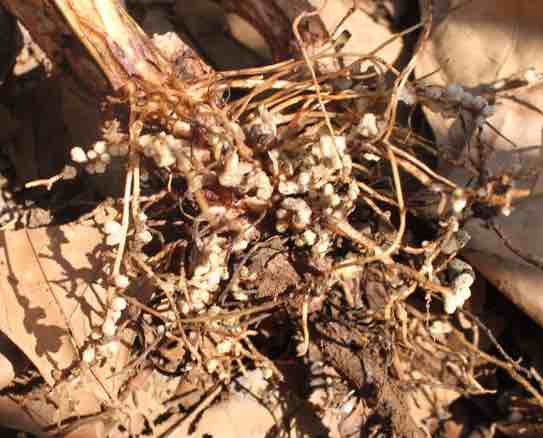
One other important fact when considering what are legumes is that their roots have nodules filled with bacteria that can harvest atmospheric nitrogen and turn it into important fertilizer[5]. The only other natural source on earth is lightning.
Inoculating rhizobia onto legume seeds will be important if you plan to grow broad beans for example.
So growing beans and peas is vital for the gardener, not just for their nutritional value as food but also because of the great benefit and savings as they provide fertilizer for subsequent crops.
When the crop is over it's not a bad idea to cut off the stalks but leave the roots in the ground for the bugs to continue their work of capturing nitrogen; it might be just as effective in the compost heap, not so?
This is all part of what we call permaculture; working with nature, rather than against it.
Bernard Preston's favourite dried pulse is the garbanzo though he grows large quantities of pole beans, green garden peas and limas; and favas too. All have their virtues and help getting us off a reliance on too much red-meat for protein.
What are legumes? They are one of the foods that provide satiety and are absolutely fundamental for those with raised blood-glucose.
Having fresh green legumes from the garden year round is our goal, so
that we can enjoy them every single day. The controversial
anti-nutrients are less problematic than in dried beans too.
That is why I am up on legumes; grasping what they are.
Do
not get me wrong, we are not vegetarians; but we recognise that if we
want to live long in the land and enjoy a life without medication, what
are legumes must be uppermost in our minds when it comes to our cooking.
They are also an essential part of good brain foods.
We have trained our tongues to love hummus and broad beans because they promote well-being and a long life. Who actually wants to get Parkinson's disease or metastatic neoplasms and take pills to lower cholesterol? Ring in the changes before the day of reckoning arrives is our motto; that means this morning.
Research shows that the cumin plus lime in hummus combine to make a dish more effective than the most common drug used for weight loss.
 Cumin and lime for weight loss.
Cumin and lime for weight loss.There is a tide in the affairs of men that, taken at the flood leads on to sparkling vitality to crib from the bard; in part it must include the virtues of legumes.
Are beans very starchy is something that may be concerning you; yes they have some carbohydrate, but less than a third of a slice of cheesecake.
Starchy or not, a moderately low carbohydrate meal associated with increased fat and protein from sources based on plants is strongly associated with greater well-being; get them exclusively from meat and your future is far more dubious(1).
It is the refined carbohydrates that are the very devil. It is time to start training our tongues that those treats high in sugar and cake flour and yes white rice and most pasta too, are strongly associated with insulin-resistance. That is the beginning of diabetes.
It may be slow to kill but the twenty year diabetes rule is remorseless and cruel; ask anyone who has lost a limb or has lost their sight from a retinopathy.
In a remarkable and very readable book, Open Andre Agassi the world's greatest tennis player tells how he survived the circuit in the early days of his career on lentils and baked potatoes; high in starch but because of the exercise and the protein in legumes it obviously never affected his blood glucose negatively.
These nitrogen fixation bacteria are obviously also vitally important when trying to reduce our reliance on inorganic fertilizers for our gardens. It is no coincidence that innovative farmers follow a crop of corn or wheat with soya beans, for example.
They are an important part of getting your garden soil ready for planting.
Are favas shell beans is a subject of some importance; the pod contains even more L-dopa than the seed. Prevention is better than a cure with all conditions but especially Parkinson's disease.
Plant-based meat alternatives
Whilst minimally-processed plant protein such as that found in legumes is almost universally recommended in combating serious illness, there are questions about the highly refined meat alternatives that are being sold today.
Owing to the addition of heme-iron to make them taste more like meat there is an increased risk of type 2 diabetes, for example. A lot more research needs to be done.
We prefer to enjoy zero-processed plant protein directly from the legumes in our garden; lentils and chickpeas are dirt cheap too.
What are legumes? They are the least expensive source of protein; cooked imaginatively they are delicious.
Hummus recipe
Legumes to be quite honest are not the most interesting and flavoursome foods; rather we eat them because they are good for us. By adding different herbs, spices and concoctions such as tahini we balance their proteins and enhance their value, making them tasty and satisfying our hunger pangs; satiety is one of their many virtues.
This hummus recipe must be the most obvious example; we enjoy it almost every day. Vegetarians use it because the balance of amino acids is important for them, more so than for us meat-lovers but we can take a leaf from their book.
Are you famished? Have a large spoonful of hummus rather than a candy bar. It will stay with you much longer. Weight loss research brings convincing evidence that diets are a complete waste of time; they simply don't work. Enjoying nutritious foods that provide satiety is the only way.
Do not buy hummus at the supermarket by the way. It is loaded with preservatives that detracts from the taste and value; and you can make it yourself in only five minutes. I have done so twice a week for the last twenty years. I have the T-shirt; it's simple.
Cooking chickpeas is central to making your own nutritious and inexpensive hummus in the kitchen; and then freezing them in small packets.
Do not buy them in cans if you are planning to do this regularly; you want to be absolutely certain that they have been properly rinsed to remove the bulk of the anti-nutrients.
These spicy roasted chickpeas make a delicious snack.
What are legumes? They are every-day foods that add variety and solid nutrition to the plate.
Broad beans and Parkinson's disease
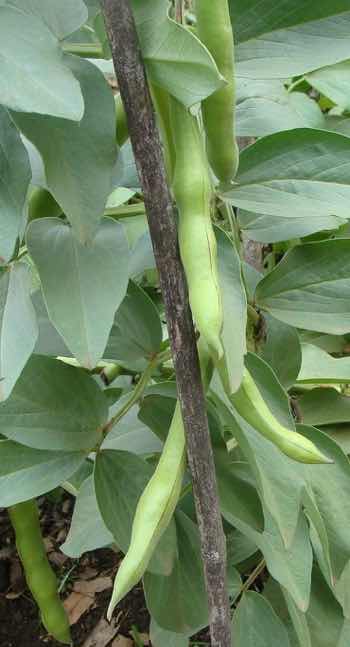
Any blog on what are legumes must surely include something on the importance of broad beans in the management of Parkinson's disease. They are the only source of bioactive compounds from our food that are able to cross the blood-brain barrier where they are converted to dopamine, a very important neurotransmitter.
They are a true functional food, promoting wellness and helping to prevent disease.
Normally dopamine is produced by nuclei in the mid-brain called the Substantia Nigra; and in the colon. Deadly chemicals may destroy these neurons that synthesize the neurotransmitter causing Parkinson's disease. The nitrate preservative in processed meat and drycleaning solvents have been fingered.
So too has constipation and a dearth of the friendly bugs found in the large intestine; research shows this creates the environment for pathogens that produce the toxins which foster the neurodegenerative diseases to flourish.
Enjoying a handful of broad beans, also known as favas enables many Parkinson's sufferers to cope with their disease without having to take drugs.
Eggs Parkinson's disease is a simple way to enjoy these delicious favas and manage your sickness. Learning how to freeze broad beans would be essential so that you would have the medicine all year long.
This fava beans nutrition page is important for anyone who wants to eat less meat; and also for those who look forward to a life without medication[3]. Only enjoy them when they are fresh and young; old and starchy, they're not much fun.
Broad bean pests can be managed organically; they can be a real bother in hot, humid weather.
Others are these Mexican bean beetle larvae which have been troublesome.
What are legumes is a fascinating subject; I hope you too are enthused about the prospects of greater well-being.
You will not find them in the shops so you will have to find out how to plant broad beans. They are the second richest source of plant protein of all legumes; about 25 percent.
Fava beans with cream and thyme is one of our great favourites.
I am glad that we save bean seeds. In the past our favas were not to be had in South Africa for love nor money; I am really not sure why but I wondered what Parkinson's sufferers did, those that relied on them for L-Dopa.
Luckily every year we can keep back seeds from our lima, Witsa and broad beans; they are often difficult to get. It is all in answer to what are legumes?
The glycemic response to fava beans is a controversial topic; why do some tables label it has being high when all other legumes are low? I would suggest that it is because they are often double-podded; both the shells and the skins are commonly removed.
Stunting of children
Stunting of children in South Africa has reached the highly-disturbing prevalence of 27 percent, far worse than many other African countries; they can never reach their true potential. And it has barely improved since independence, a quarter of a century ago.
Simply placing half a cup of legumes, one mealie cob and an apple into the hand of every child each day would almost completely alleviate this distressing situation. Add an egg, quarter of an avocado and a glass of milk and they would be quite normal and strong.
What are legumes is a consuming subject; let's find out more about them.
So legumes are an excellent source of protein; but with so many stunted children also being obese the question arises whether peanut butter is keto or not. Will it simply add to their weight problems?
Understanding the nutritional value of green beans would do wonders for those caring for stunted, starving children.
Longevity diet
The longevity diet is rich in legumes, whole grains and nuts with reduced red and processed-meat; there is increased life expectancy of 10.7 years in women and 13y in men.
The emphasis is not only living to strong and vigorous eighties and nineties but good years towards the end. Much is similar to Blue Zone longevity but includes the fasting-mimicking diet for five days, once every four months.
From the garden
Mixed kale and beans make wonderful nutritious greens, fit for a king who has no desire to go blind, or have a stroke; it is all about lutein and the vegetable protein from legumes.
Turning it into eggs Hilton makes the perfect nutritious breakfast that will not like cereal cause your blood glucose to soar, and then drop precipitously so that you are famished at 11 o'clock.
Let's get seriously into what are legumes. Grow a mountain of them in your own garden[4].
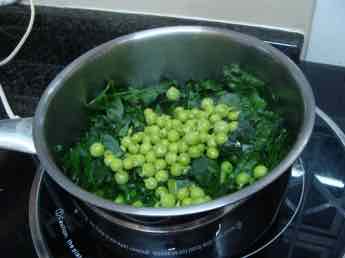
There is a relative simple cycle that enables one to enjoy the fruit of your studies about what are legumes directly from the garden.
In spring after the danger of frost is over, find out about peas and growing green beans; they are a wonderful source of the fruit legumes.
It is astonishing how long just a few pole beans will go on bearing, and providing the family with a vegetable source of protein.
In early summer, it is time to figure out growing lima beans; they need a long time to mature and patience is needed. Roll on the suffering succotash; you will also need to know about cooking lima beans. Answering the question what are legumes need not be so difficult.
Succotash recipe combines the goodness of one of our favourite legumes, the lima with mealie kernels; really just corn and beans.
In late summer, and in spring for that matter, it is all about how to plant the broad beans, also known as favas.
Well before winter we need to know about how to grow peas to get them established before the cold sets in.
So there you have it; from the garden you can enjoy legumes for most of the year. Add to them the lentils and chickpeas and you will have little need for red meat; by 2050 our burgeoning population will simply be forced to eat this way.
We do it willingly, simply to enjoy greater well-being; we have no desire to get tumours or have a stroke. It is an important step too if you want to enjoy your meals without a pillbox on the table.
Can you now answer the question? What are legumes? I hope so. Eat them, they are good for you and for the environment.
This peanut and ginger sauce is another of our legume-rich condiments to brighten up a green salad. Vegetable high in protein means legumes.
What are legumes? It's all about greater wellness; cooked imaginatively they are delicious.
Copy and paste "vegetable high in protein" for example into Site Search for more information.
New varieties
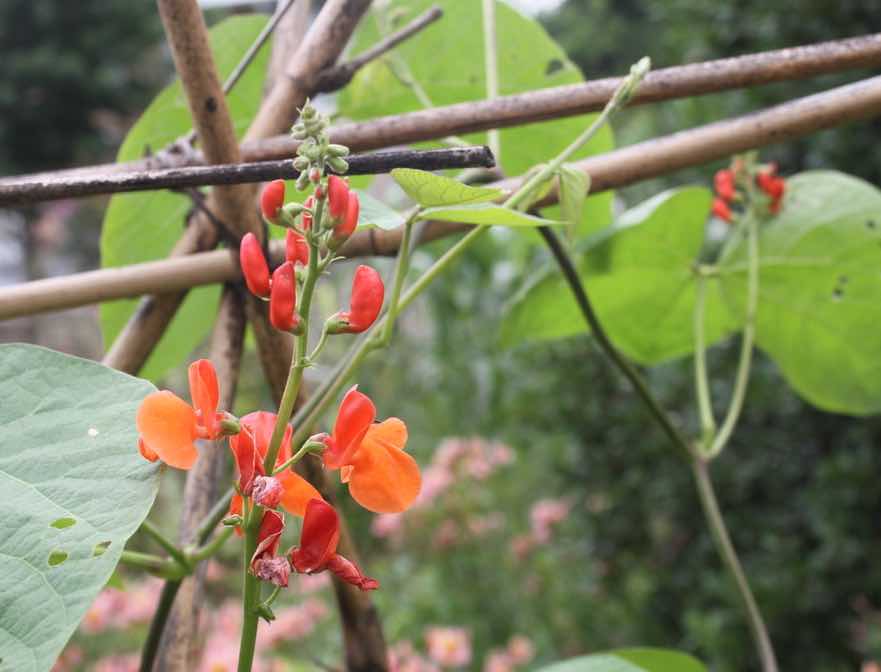
It is always good to look for new varieties in our search to answer the question what are legumes? Some are in vogue but there are others that may be rather obscure; each contributes its own special flavour to the mix.
Apart from the fact they each provide their own particular mix of vegetable protein and phytochemicals, they fruit at different times, giving you a much longer season along with the greater variety.
This year it is the scarlet runner bean. At this stage I really do not know what it tastes like; soon we will be able to report on progress. What are legumes? There are many different ways to get away from meat that was raised in a sty, barn or feedlot, pumped with hormones and antibiotics; and fed mainly on corn.
That means too much omega-6, which equals pain and inflammation; and a colon devoid of much of its friendly bacteria and yeasts, the second brain.
It is with a heavy heart I say that. I too love a good steak but getting organic-meat is becoming increasingly difficult; and animals are certainly one of the causes of water scarcity in the world. Hence our interest in what are legumes.
This lentil with lemon salad makes a great dish; prepare it from start to finish in less than fifteen-minutes.
This very simple lentil potage is a great favourite in our household; we often substitute with green legumes such a scarlet runner beans or favas for variety.
This is the best way to cook lentils; keep them in the fridge for a snack, or a substitute for hummus. There's an added sauce to give it flavour.
What are legumes?
Can you now answer the question?
Useful links
Here are a few more useful links at what are legumes. The cooking time for dried beans depends on many factors; generally they taste best if you retain the water in which they are boiled.
- Food carbohydrate intake and mortality: a prospective cohort study and meta-analysis
- Insight Into the Prospects for the Improvement of Seed Starch in Legume
- Life without medication. Web: https://tinyurl.com/3r22399e
- Grow a mountain of legumes
- Nitrogen fixation bacteria
When browsing use right click and Open Link in New Tab, or you may get a bad gateway signal.
Newsletter
Our newsletter is entitled "create a cyan zone" at your home, preserving both yourself and Mother Earth for future generations; and the family too, of course. We promise not to spam you with daily emails promoting various products. You may get an occasional nudge to buy one of my books.
Here are the back issues.
- Lifestyle and ideal body weight
- What are ultra-processed foods?
- Investing in long-term health
- Diseases from plastic exposure
- Intensive lifestyle management for obesity has limited value
- A world largely devoid of Parkinson's Disease
- The impact of friendly bacteria in the tum on the prevention of cancer
- There's a hole in the bucket
- Everyone is talking about weight loss drugs
- Pull the sweet tooth
- If you suffer from heartburn plant a susu
- Refined maize meal and stunting
- Should agriculture and industry get priority for water and electricity?
- Nature is calling
- Mill your own flour
- Bake your own sourdough bread
- Microplastics from our water
- Alternative types of water storage
- Wear your clothes out
- Comfort foods
- Create a bee-friendly environment
- Go to bed slightly hungry
- Keep bees
- Blue zone folk are religious
- Reduce plastic waste
- Family is important
- What can go in compost?
- Grow broad beans for longevity
- Harvest and store sunshine
- Blue zone exercise
- Harvest and store your rainwater
- Create a cyan zone at your home
Did you find this page interesting? How about forwarding it to a friendly book or food junkie? Better still, a social media tick would help.
- Bernard Preston homepage
- Legumes
Address:
56 Groenekloof Rd,
Hilton, KZN
South Africa
Website:
https://www.bernard-preston.com